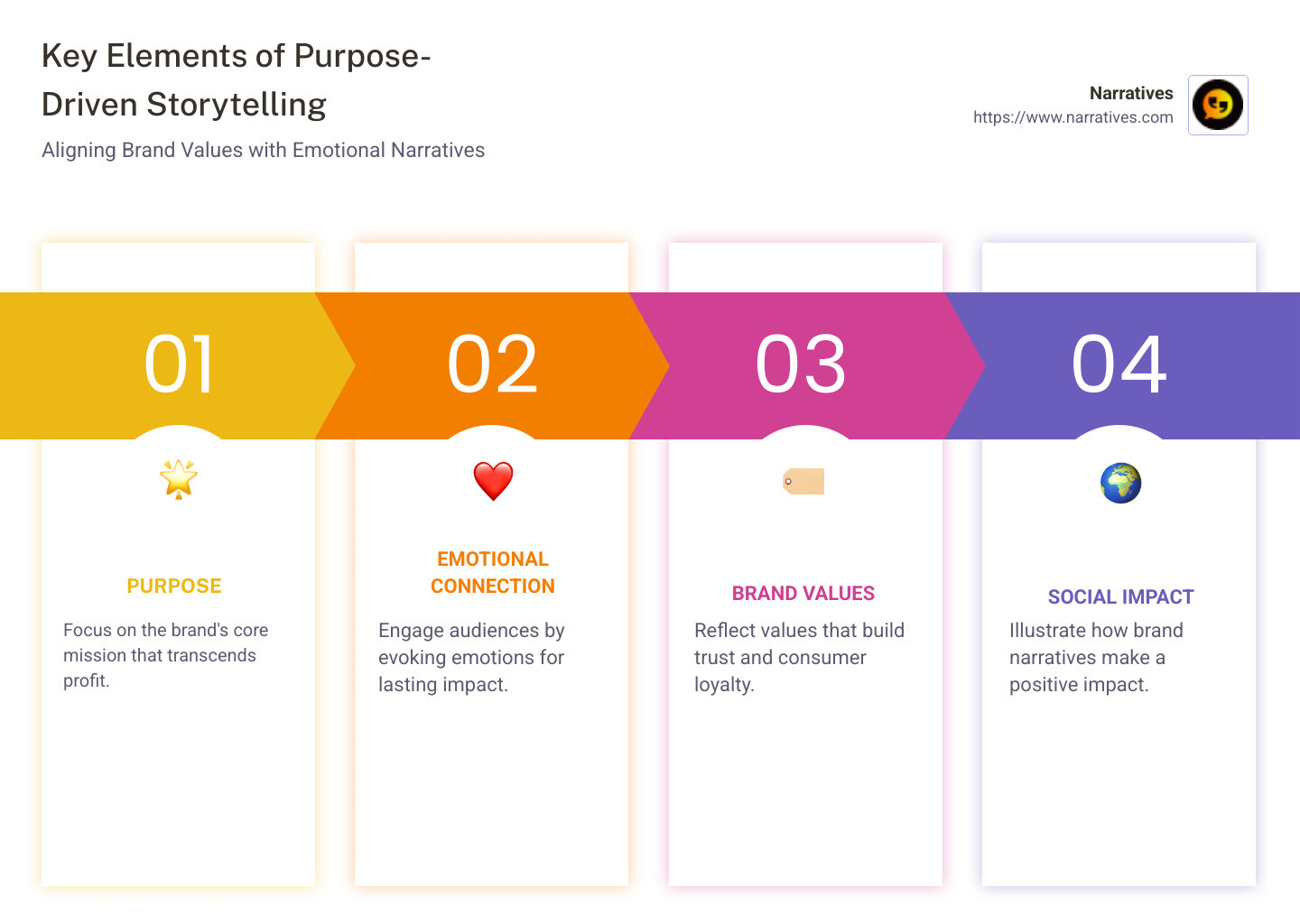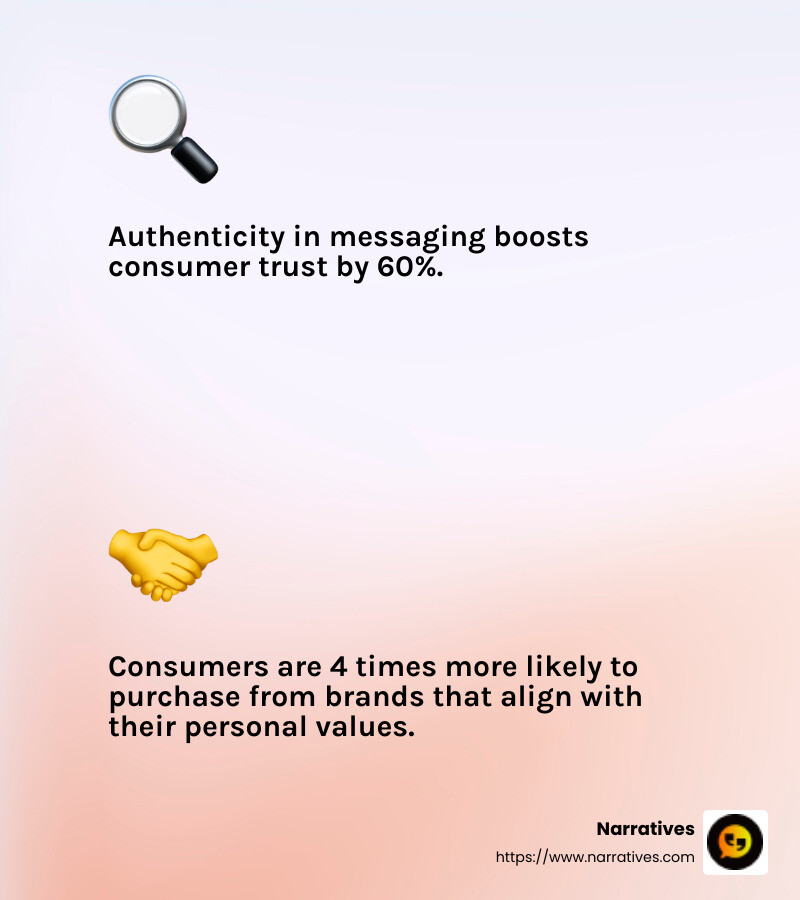The Power of Purpose: Storytelling That Resonates

Purpose-driven storytelling is a powerful marketing approach that goes beyond simply promoting products or services. It's all about creating a deep emotional connection with audiences by aligning brand values with the stories being told.
Here's what you need to know:
- Purpose: It involves a brand's core mission, which is more than just profit. It's about making a positive impact and resonating with the values of consumers.
- Emotional Connection: Effective storytelling evokes emotions, making content memorable and engaging.
- Brand Values: Stories that reflect a brand's values help build trust and loyalty with audiences who share those beliefs.
Purpose-driven storytelling leverages the timeless art of storytelling to engage audiences on emotional levels. It captures the essence of what a brand stands for and communicates in a way that connects with people's values and beliefs. As psychology shows, people are wired to respond to stories. They remember narratives that strike a chord emotionally, rather than mere facts or figures.
In today’s socially conscious marketplace, consumers are increasingly drawn to brands that are transparent and authentic in their missions. Brands like Chipotle, TOMS, and Hiut Denim exemplify purpose-driven storytelling by weaving their values and missions into their narratives to foster trust and customer loyalty.
By focusing on purpose-driven storytelling, brands can differentiate themselves in a crowded market and foster a community of loyal supporters.

Purpose-driven storytelling terms to remember:
Understanding Purpose-Driven Storytelling
Purpose-driven storytelling is more than just a buzzword—it's a strategy that can transform how brands connect with their audience. At its core, it involves sharing stories that align with a brand's mission and values, ultimately creating an emotional bond with consumers.
The Role of Authenticity
Authenticity is the backbone of purpose-driven storytelling. In a world filled with marketing noise, consumers crave genuine connections. They can quickly spot inauthentic messaging or "purpose-washing"—where brands pretend to care about social issues just to boost sales.
To build trust and loyalty, brands must communicate their core mission sincerely. Authentic messaging involves transparency about what a brand stands for and how it acts on its values. This honesty fosters trust, making consumers more likely to become loyal advocates.

Consider the example of Patagonia. This brand doesn't just sell outdoor gear; it’s committed to environmental activism. By sharing stories of their efforts to protect the planet, Patagonia builds a genuine connection with its audience, reinforcing trust and loyalty.
Emotional Resonance in Storytelling
Stories have a unique power to engage our emotions. They help us connect on a human level, making narratives memorable and impactful. Brands that master emotional storytelling can create lasting impressions.
Purpose-driven storytelling taps into this by crafting narratives that resonate emotionally. When a story aligns with a consumer's personal values, it becomes more than just a brand message—it becomes a part of their own story.
For example, Dove's "Real Beauty" campaign challenges beauty stereotypes and celebrates diversity. By telling stories that highlight real people and their experiences, Dove creates emotional engagement and strengthens its brand identity.
Purpose-driven storytelling is about humanizing a brand. It uses authentic narratives to build emotional connections, ensuring that the brand is remembered not just for its products, but for what it stands for. This approach can turn consumers into passionate supporters who align with the brand’s mission and values.
The Impact of Purpose-Driven Storytelling
Building Emotional Connections
Purpose-driven storytelling is a powerful tool for forging deep emotional connections. When a brand tells stories that reflect its mission and values, it resonates emotionally with consumers. This connection is not just about selling products—it's about creating a shared vision and building a community of loyal consumers who believe in the brand's purpose.
Consider a brand that shares stories of individuals in underserved communities who benefit from its programs. By focusing on real human impact, the brand creates an emotional bond with its audience. This storytelling approach turns consumers into advocates for the brand.

These emotional bonds are crucial in today's marketplace, where consumers are overwhelmed by choices. Brands that succeed in building these connections enjoy stronger consumer trust and loyalty.
Competitive Advantage through Storytelling
In a crowded market, purpose-driven storytelling offers a significant competitive advantage. Brands that align their mission with their storytelling stand out by showcasing their uniqueness and commitment to social impact.
For instance, a company dedicated to environmental stewardship can weave this commitment into its brand narrative. By aligning their mission with their business practices, the company differentiates itself from competitors and attracts consumers who share its vision for a sustainable future.
This alignment of mission and storytelling not only improves brand uniqueness but also fosters consumer trust. Consumers today, especially Millennials and Gen Z, are drawn to brands that are transparent about their values and actions. They seek out companies that reflect their own beliefs and contribute positively to society.
Moreover, the rise of impact investing highlights how venture capitalists are increasingly interested in purpose-driven startups. These businesses, which prioritize social and environmental goals alongside financial returns, are seen as long-term investments with strong consumer loyalty and staying power.
In conclusion, purpose-driven storytelling is not just a marketing strategy—it's a way to build meaningful relationships with consumers. By focusing on emotional connections and mission alignment, brands can differentiate themselves, build trust, and inspire loyalty in a changing market.
Techniques for Effective Purpose-Driven Storytelling
Identifying Core Values
To effectively engage in purpose-driven storytelling, brands must first identify their core values. This is the foundation upon which all narratives are built. Core values define a brand's mission and guide its storytelling efforts.
Start by asking: What does our brand stand for? and How do we want to impact the world? These questions help craft a narrative that aligns with the brand's mission and resonates with consumers.
Consumer alignment is crucial. When a brand's values align with those of its audience, it creates a strong connection. For instance, Dove's "Real Beauty" campaign aligns with consumers who value diversity and self-acceptance. This alignment not only attracts like-minded consumers but also strengthens brand loyalty.
To demonstrate values effectively, brands can use storytelling frameworks like the Hero's Journey. This classic framework involves a protagonist overcoming challenges, which mirrors the brand's journey and mission. By using such frameworks, brands can craft compelling narratives that highlight their values in action.
Humanizing the Brand
Humanizing a brand involves creating relatable characters and telling emotional stories that foster empathy. People connect with stories that feature real human experiences and emotions.
Consider Ben & Jerry's approach. The brand uses humor and creativity to tackle serious issues like climate change and social justice. By humanizing these topics, they engage audiences on an emotional level, making the message more memorable and impactful.
Consumer empathy is key here. When consumers see themselves or their values reflected in a brand's story, they form a deeper connection. This is achieved by focusing on relatable characters and real-life scenarios. For example, Patagonia's stories about environmental activists resonate with consumers who care about sustainability.
To improve audience engagement, brands should incorporate multimedia elements such as videos and images. Visual storytelling can convey emotions more effectively than text alone. A well-crafted video can immerse viewers in the brand's story, making them feel part of the journey.
In summary, effective purpose-driven storytelling requires identifying core values and humanizing the brand. By aligning narratives with consumer values and creating emotional connections, brands can build trust, inspire loyalty, and stand out in a crowded market.
Frequently Asked Questions about Purpose-Driven Storytelling
What is purpose-driven storytelling?
Purpose-driven storytelling is the art of crafting narratives around a brand's core mission and values. It's not just about selling products or services; it's about creating a deeper connection with the audience by aligning with their values and aspirations. Brands like Patagonia and Dove excel in this by integrating their missions—such as environmental sustainability and diversity—into their stories. This approach transforms a brand from a mere business entity into a meaningful presence in consumers' lives.
How does storytelling build brand trust?
Storytelling builds trust by showcasing a brand's authenticity and commitment to its values. When a brand shares genuine stories, it opens up about its mission, challenges, and successes. This transparency invites consumers into the brand's world, fostering a sense of reliability and sincerity. For instance, Ben & Jerry's uses humor and creativity to discuss serious social issues, which not only engages audiences but also builds trust by showing the brand's genuine commitment to social justice.
Why is authenticity important in storytelling?
Authenticity is crucial because consumers are quick to spot insincerity or greenwashing. An authentic story resonates with audiences because it reflects the true essence of the brand. Authenticity in storytelling means being honest about your brand's journey, including the challenges faced and the steps taken to overcome them. This honesty builds a connection with consumers, making them more likely to trust and engage with the brand. As studies show, nearly two-thirds of consumers make purchasing decisions based on a brand’s stance on social and environmental issues, highlighting the importance of authenticity in storytelling.
Conclusion
Purpose-driven storytelling is more than a marketing strategy—it's a powerful tool for social impact and community-building. At Narratives, we believe in the transformative power of stories to lift underrepresented voices and create meaningful change.
Narratives are not just about telling a story; they are about sharing a mission. By focusing on the human element and emotional resonance, stories connect people to causes and inspire action. This is especially important for non-profits and purpose-driven organizations aiming to make a difference. When organizations share their impact through genuine and heartfelt stories, they build trust and foster a sense of community.
Social impact is at the heart of purpose-driven storytelling. When a brand or organization shares its journey, challenges, and victories, it opens a dialogue with its audience. This transparency not only builds trust but also encourages others to join the cause. Brands that integrate social impact into their narratives stand out in a crowded market by showing they care about more than just profits.
Community storytelling takes this a step further by involving the audience in the narrative. When people see themselves reflected in a story, they feel a sense of belonging. This connection turns audiences into advocates and supporters. At Narratives, we help organizations craft stories that resonate on a personal level, driving engagement and building a loyal community around shared values.
When consumers are increasingly driven by purpose, embracing purpose-driven storytelling is not just beneficial—it's essential. By aligning stories with core values and missions, organizations can inspire change, foster community, and make a lasting impact.
Explore how Narratives can help you craft your purpose-driven story and amplify your social impact by learning more.


